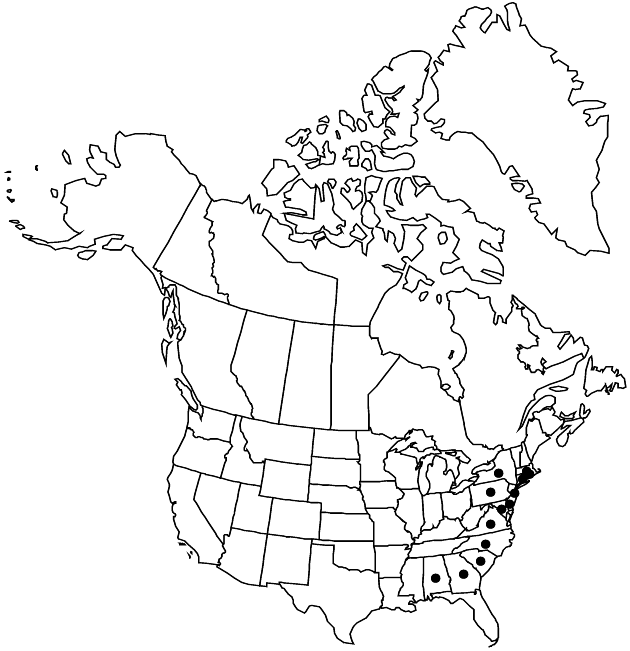Eurybia spectabilis
Phytologia 77: 262. 1995.
Plants 10–90 cm; forming clones and clumps with rosettes, new shoots at end of rhizomes and bases of old stems; rhizomes elongate, scaly, herbaceous becoming woody. Stems 1–3, erect or sometimes ascending, straight, often stout, sometimes glabrous or glabrescent, usually ± sparsely villous proximally and/or distally, proximally eglandular to ± short-stipitate-glandular, distally glandular from 1/2–2/3, short and long-stipitate-glandular in arrays. Leaves basal and cauline, firm (reticulately veined), margins slightly revolute, indurate, entire or remotely crenulate-serrulate, scabrous, teeth indurate, apices acute (seldom basal obtuse), indurate, faces usually scabrous (especially abaxially), sometimes glabrous; basal and proximal cauline persistent, petioles (10–90 mm) ± narrowly winged (wings wider and shorter distally), bases sometimes marcescent, blades lanceolate or elliptic to ovate or obovate-elliptic or spatulate, 10–160 × 3–40 mm (earlier leaves smallest), bases attenuate; mid widely winged-petiolate to subpetiolate or sessile, blades elliptic-lanceolate, ovate, or ± narrowly obovate to spatulate, oblanceolate, or lanceolate, 13–105 × (2–) 5–30 mm, ± gradually reduced distally, bases attenuate or cuneate, sometimes ± clasping or sheathing (proximal); distal (arrays) sessile, oblong or narrowly ovate to linear-lanceolate or linear, 6–40 × 1–11 mm, usually abruptly reduced, becoming ± glandular. Heads (1–) 3–35+ usually in open, corymbiform arrays, seldom borne singly, branches ascending, stout. Peduncles sometimes sparsely villous, densely stipitate-glandular; bracts (0–) 1–3, leaflike or sometimes phyllary-like (bases rounded, membranous, indurate), sometimes immediately subtending heads, densely stipitate-glandular. Involucres campanulate, 7.5–14 (–16) mm, ± equaling pappi. Phyllaries 35–70 in 5–6 series, oblong-lanceolate to sometimes spatulate (outer) to linear-lanceolate or linear (inner), unequal, membranous or sometimes foliaceous (outer), bases indurate, rounded (outer), green zones expanded, ovate to obovate (outer, sometimes foliaceous to base) or diffusely lanceolate or none (inner), margins of membranous parts hyaline or ± purplish (inner), narrowly scarious, villoso-ciliate or long-stipitate-glandular, of foliaceous parts ± indurate, scabrous or short-stipitate-glandular, apices squarrose (outer) to ± appressed (innermost), acute to obtuse, adaxial faces long-stipitate-glandular (foliaceous parts). Ray-florets 15–35; corollas violet-purple, 12–25 × 1.6–4 mm. Disc-florets 25–55; corollas yellow, 5.5–7.6 mm, ± ampliate, tubes shorter than funnelform throats, lobes erect, lanceolate, 0.7–1.2 mm. Cypselae brown, fusiform, slightly compressed, 3–4.2 mm, ribs 12–14, faces densely strigillose; pappi of reddish-tawnish bristles 5.3–7.6 mm, ± equaling disc corollas. 2n = 72.
Phenology: Flowering fall.
Habitat: Mostly sandy soils, sometimes dry clay, granite outcrops, dry, oak-pine woods, pine barrens, peat bogs, borders of woods, clearings, fields, roadsides
Elevation: 0–900 m
Distribution

Ala., Conn., Del., Ga., Md., Mass., N.J., N.Y., N.C., Pa., R.I., S.C., Va.
Discussion
Eurybia spectabilis is of conservation concern in much of its range, notably in Pennsylvania, Delaware, and Maryland. It is an eastern coastal plains species that reaches its southern limit in Alabama and Georgia.
Selected References
None.
Lower Taxa
"[" is not declared as a valid unit of measurement for this property."]" is not declared as a valid unit of measurement for this property.